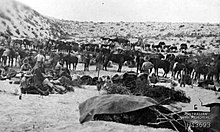Battle of Romani
1915: Suez Canal
1917: Rafah - Gaza (1) - Gaza (2) - Beersheba - Gaza (3) - El Mughar - Jerusalem
1918: Jericho - Tell 'Asur - Jordan (1) - Jordan (2) - Abu Tellul - Megiddo
The Battle of Romani took place from August 3rd to 5th, 1916 near Romani on the Sinai Peninsula . During the battle, Ottoman units attacked positions of the advancing British. The attack ended with the withdrawal of the Ottoman troops after heavy losses
background
In the war year 1916 , the Egyptian Expeditionary Force under General Archibald Murray was established on March 10 to protect the Suez Canal , which was threatened by the Ottoman troops , with General Arthur Lynden-Bell serving as Chief of Staff .
The duck test forces advanced along the coastal route from Egypt via the Sinai to Palestine as their final destination. The Ottoman troops had already carried out a successful disruptive attack near Qatiya in April 1916. The Ottoman commander in chief for the theater of war, Cemal Pasha , had set himself another attack with the ultimate goal of threatening the Suez Canal.
course
On August 3, 1916, an Ottoman unit of around 16,000 soldiers began the attack on the British positions held by the 52nd (Lowland) Division (Lieutenant General HA Lawrence ) and the ANZAC Mounted Division (Major General Chauvel ).
The attack occurred simultaneously with the return of an ANZAC patrol. As a result, the Ottoman armed forces achieved a surprise effect and were able to almost completely enclose a cavalry regiment. After recovering from the initial shock of the attack, the British forces brought in reserves and gradually became the dominant force in the fighting. This prompted the commander of the Ottoman troops, Kreß zu Kressenstein , to break away from the battle and to retreat towards al-Arish . When retreating, several hundred soldiers remained in isolated small units, who capitulated in the course of the battle. The British forces tried to pursue the Ottoman forces with planes and ground troops. However, the Ottoman troops succeeded in an orderly retreat, including their artillery , by means of counter attacks .
consequences
The Ottoman side recorded 1,500 deaths and around 4,000 prisoners of war. The British side reported losses of 200 dead and 900 wounded. The battle of Romani was the last offensive operation of the Ottoman army in the Sinai campaign, after which the initiative passed to the duck test forces. Immediately thereafter, the British began to gradually recapture the Sinai Peninsula and, as a result of the Battle of Magdhaba (December 28, 1916), were able to take the border fortress town of al-Arish. In the spring of 1917, the Ottoman 4th Army under Ahmet Cemal Pasha defended the newly formed Palestine Front . The advance of British troops was only stopped on the line between Gaza and Tell el Sheria.
Individual evidence
- ^ A b c d Eugene L. Rogan: The Fall of the Ottomans: The Great War in the Middle East 1914–1920. London 2016, pp. 313-316.
- ↑ Ulrich Trumpener: Turkey's War. in Hew Strachan The Oxford Illustrated History of the First World War: New Edition. Oxford, 2016, e-book without page numbers


